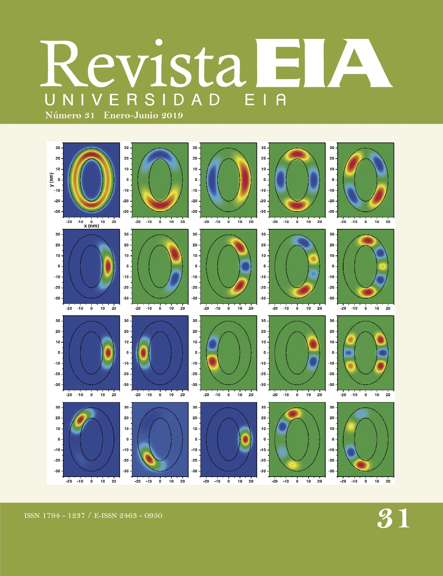Mortero geopolimérico para uso potencial como recubrimiento en concreto
Mortero geopolimérico para uso potencial como recubrimiento en concreto
Barra lateral del artículo
Términos de la licencia (VER)
Declaración del copyright
Los autores ceden en exclusiva a la Universidad EIA, con facultad de cesión a terceros, todos los derechos de explotación que deriven de los trabajos que sean aceptados para su publicación en la Revista EIA, así como en cualquier producto derivados de la misma y, en particular, los de reproducción, distribución, comunicación pública (incluida la puesta a disposición interactiva) y transformación (incluidas la adaptación, la modificación y, en su caso, la traducción), para todas las modalidades de explotación (a título enunciativo y no limitativo: en formato papel, electrónico, on-line, soporte informático o audiovisual, así como en cualquier otro formato, incluso con finalidad promocional o publicitaria y/o para la realización de productos derivados), para un ámbito territorial mundial y para toda la duración legal de los derechos prevista en el vigente texto difundido de la Ley de Propiedad Intelectual. Esta cesión la realizarán los autores sin derecho a ningún tipo de remuneración o indemnización.
La autorización conferida a la Revista EIA estará vigente a partir de la fecha en que se incluye en el volumen y número respectivo en el Sistema Open Journal Systems de la Revista EIA, así como en las diferentes bases e índices de datos en que se encuentra indexada la publicación.
Todos los contenidos de la Revista EIA, están publicados bajo la Licencia Creative Commons Atribución-NoComercial-NoDerivativa 4.0 Internacional
Licencia
![]()
Esta obra está bajo una Licencia Creative Commons Atribución-NoComercial-NoDerivativa 4.0 Internacional
Contenido principal del artículo
Resumen
Se sintetizaron dos morteros geopoliméricos basados en Metacaolín y residuo de ladrillo, modificados con adiciones orgánicas e inorgánicas para ser utilizados como potenciales recubrimientos sobre concretos. Se evaluaron sus propiedades en estado fresco (fluidez, tiempo de fraguado) y en estado endurecido (resistencia a la compresión y tracción, absorción, porosidad y conductividad térmica). Los resultados muestran la viabilidad de producir morteros Clase R1 y R2 en concordancia con la Norma EN 1504-3 en cuanto a las propiedades mecánicas y se evidencia que los sistemas geopoliméricos producidos presentan menor conductividad térmica comparada a los morteros basados en OPC sugiriendo comportamiento tipo aislante.
Descargas
Detalles del artículo
Katherine Oviedo-Sánchez, Universidad del Valle
Ingeniera de Materiales, Joven Investigador Grupo Materiales CompuestosRuby Mejía de Gutiérrez, Universidad del Valle
Doctor en Ciencias Químicas Profesor Titular Universidad del Valle Director de la Escuela de Ingeniería de Materiales, Universidad del Valle, Director Grupo Materiales CompuestosReferencias (VER)
Duan, P.; Yan, C.; Luo, W.; Zhou, W. (2016). Effects of adding nano-TiO2 on compressive strength, drying shrinkage, carbonation and microstructure of fluidized bed fly ash based geopolymer paste. Constr. Build. Mater., 106, pp. 115-125. doi: 10.1016/j.conbuildmat.2015.12.095.
Irfan Khan, M.; Azizli, K.; Sufian, S.;Man, Z. (2014). Effect of Na/Al and Si/Al Ratios on Adhesion Strength of Geopolymers as Coating Material. Appl. Mech. Mater., 625, pp. 85-89. doi: 10.4028/www.scientific.net/AMM.625.85.
Irfan Khan, M.; Azizli, K.; Sufian, S.;Man, Z. (2015). Sodium silicate-free geopolymers as coating materials: Effects of Na/Al and water/solid ratios on adhesion strength. Ceram. Int., 41(2), pp. 2794-2805. doi: 10.4028/www.scientific.net/AMM.625.85.
Krivenko, P.V.; Guzii, S.G.; Bodnarova, L.; Valek, J.; Hela, R.; Zach, J. (2016). Effect of thickness of the intumescent alkali aluminosilicate coating on temperature distribution in reinforced concrete. J. Build. Eng., 8, pp. 14-19. doi: 10.1016/j.jobe.2016.09.003.
Lee, N.K.; Kim, E.M.; Lee, H.K. (2016). Mechanical properties and setting characteristics of geopolymer mortar using styrene-butadiene (SB) latex. Constr. Build. Mater., 113, pp. 264-272. doi: 10.1016/j.conbuildmat.2016.03.055.
Liew, Y.M.; Heah, C.Y; Mohd Mustafa, A.B.; Kamarudin, H. (2016). Structure and properties of clay-based geopolymer cements: A review. Prog. Mater. Sci., 83, pp. 595-629. doi: 10.1016/j.pmatsci.2016.08.002.
Mermerdaş, K.; Manguri, S.; Nassani, D.E.; Oleiwi, S.M. (2017). Effect of aggregate properties on the mechanical and absorption characteristics of geopolymer mortar.Eng. Sci. Technol. an Int. J., 20(6), pp. 1642-1652. doi: 10.1016/j.jestch.2017.11.009.
Mu, S.; Liu, J.; Lin, W.; Wang, Y.; Liu, J.; Shi, L.; Jiang, Q. (2017). Property and microstructure of aluminosilicate inorganic coating for concrete: Role of water to solid ratio. Constr. Build. Mater., 148, pp. 846-856. doi: 10.1016/j.conbuildmat.2017.05.070.
Pacheco-Torgal, F.; Abdollahnejad, Z.; Miraldo, S.; Baklouti, S.; Ding, Y. (2012). An overview on the potential of geopolymers for concrete infrastructure rehabilitation. Constr. Build. Mater., 36, pp. 1053-1058. doi: 10.1016/j.conbuildmat.2012.07.003.
Robayo, R.A.; Mulford, A.; Munera, J.; and Mejía de Gutiérrez, R. (2016). Alternative cements based on alkali-activated red clay brick waste. Constr. Build. Mater., 128, pp. 163-169. doi: 10.1016/j.conbuildmat.2016.10.023.
Tamburini, S.; Natali, M.; Garbin, E.; Panizza, M.; Favaro, M.; Valluzzi, M.R. (2017). Geopolymer matrix for fibre reinforced composites aimed at strengthening masonry structures. Constr. Build. Mater., 141, pp. 542-552. doi: 10.1016/j.conbuildmat.2017.03.017.
Vejmelková, E.; Koňáková, D.; Čáchová, M.; Keppert, M.; Černý, R. (2012). Effect of hydrophobization on the properties of lime–metakaolin plasters. Constr. Build. Mater., 37, pp. 556-561. doi: 10.1016/j.conbuildmat.2012.07.097.
Villaquirán-Caicedo, M.A.; M. de Gutiérrez, R.; Sulekar, S.; Davis, C.; Nino, J.C. (2015). Thermal properties of novel binary geopolymers based on metakaolin and alternative silica sources. Appl. Clay Sci., 118, pp. 276-282. doi: 10.1016/j.clay.2015.10.005.
Wiyono, D.; Antoni; Hardjito, D. (2015). Improving the Durability of Pozzolan Concrete Using Alkaline Solution and Geopolymer Coating. Procedia Eng., 125, pp. 747-753. doi: 10.1016/j.proeng.2015.11.121.
Xu, H.; Van Deventer, J.S J. (2000). The geopolymerisation of alumino-silicate minerals. Int. J. Miner. Process., 59(3), pp. 247-266. doi: 10.1016/S0301-7516(99)00074-5.
Zhang, Z.; Wang, K.; Mo, B.; Li, X.; Cui, X.(2015). Preparation and characterization of a reflective and heat insulative coating based on geopolymers. Energy Build., 87, pp. 220-225. doi: 10.1016/j.enbuild.2014.11.028.
Zhuang, X.Y.; Chen, L.; Komarneni, S.; Zhou, C.H.; Tong, D.S.; Yang, H.M.; Yu, W H.; Wang, H. (2016). Fly ash-based geopolymer: clean production, properties and applications. J. Clean. Prod., 125, pp. 253-267. doi: 10.1016/j.jclepro.2016.03.019.


 PDF
PDF
 FLIP
FLIP







